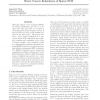99
Voted
ICML
2007
IEEE
16 years 1 months ago
2007
IEEE
We combine linear discriminant analysis (LDA) and K-means clustering into a coherent framework to adaptively select the most discriminative subspace. We use K-means clustering to ...
94
Voted
ICML
2007
IEEE
16 years 1 months ago
2007
IEEE
Markov decision processes are an effective tool in modeling decision-making in uncertain dynamic environments. Since the parameters of these models are typically estimated from da...
101
click to vote
ICML
2007
IEEE
16 years 1 months ago
2007
IEEE
We present a new machine learning approach for 3D-QSAR, the task of predicting binding affinities of molecules to target proteins based on 3D structure. Our approach predicts bind...
ICML
2007
IEEE
16 years 1 months ago
2007
IEEE
We present an intuitive scheme for lossy color-image compression: Use the color information from a few representative pixels to learn a model which predicts color on the rest of t...
98
Voted
ICML
2007
IEEE
16 years 1 months ago
2007
IEEE
Although support vector machines (SVMs) for binary classification give rise to a decision rule that only relies on a subset of the training data points (support vectors), it will ...
87
Voted
ICML
2007
IEEE
16 years 1 months ago
2007
IEEE
We propose a local, generative model for similarity-based classification. The method is applicable to the case that only pairwise similarities between samples are available. The c...
109
Voted
ICML
2007
IEEE
16 years 1 months ago
2007
IEEE
The paper is concerned with learning to rank, which is to construct a model or a function for ranking objects. Learning to rank is useful for document retrieval, collaborative fil...
98
Voted
ICML
2007
IEEE
16 years 1 months ago
2007
IEEE
Cluster analysis of ranking data, which occurs in consumer questionnaires, voting forms or other inquiries of preferences, attempts to identify typical groups of rank choices. Emp...
94
Voted
ICML
2007
IEEE
16 years 1 months ago
2007
IEEE
Optimization algorithms for large margin multiclass recognizers are often too costly to handle ambitious problems with structured outputs and exponential numbers of classes. Optim...
ICML
2007
IEEE
16 years 1 months ago
2007
IEEE
We address classification problems for which the training instances are governed by a distribution that is allowed to differ arbitrarily from the test distribution--problems also ...


